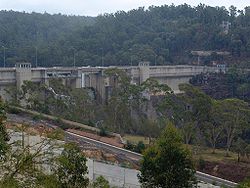
1998 Sydney water crisis
Encyclopedia

Sydney
Sydney is the most populous city in Australia and the state capital of New South Wales. Sydney is located on Australia's south-east coast of the Tasman Sea. As of June 2010, the greater metropolitan area had an approximate population of 4.6 million people...
's main water supply, the Warragamba Dam
Warragamba Dam
Warragamba Dam is the primary water source for the Australian city of Sydney. It is approximately to the west of Sydney on the Warragamba River, a tributary of the Hawkesbury River, and impounds Lake Burragorang.- Overview :...
, by the microscopic pathogens cryptosporidium
Cryptosporidium
Cryptosporidium is a protozoan that can cause gastro-intestinal illness with diarrhea in humans.Cryptosporidium is the organism most commonly isolated in HIV positive patients presenting with diarrhea...
and giardia
Giardia
Giardia is a genus of anaerobic flagellated protozoan parasites of the phylum Metamonada in the supergroup "Excavata" that colonise and reproduce in the small intestines of several vertebrates, causing giardiasis, commonly known as Beaver fever...
between July and September 1998.
Low levels of cryptosporidium and giardia were first detected in the water supply on 21 July. The levels were within acceptable health limits. In days following, much higher levels were recorded, and on 27 July the first "boil water" alert (in which residents were instructed to boil their tap water before use) was declared for the eastern Central Business District (CBD). On 29 July a "boil water" alert was issued for the south of Sydney Harbour and on 30 July a Sydney-wide "boil water" alert was issued.
The Sydney Water Corporation
Sydney Water
Sydney Water is a New South Wales government owned corporation that provides drinking water, wastewater and some stormwater services to Sydney, Illawarra and the Blue Mountains, in Australia...
announced the water safe to drink again on 4 August.
The contamination was caused by low-quality raw water
Raw water
Raw water is water taken from the environment, and is subsequently treated or purified to produce potable water in a water purification works. Raw water should not be considered safe for drinking or washing without further treatment....
entering the dam. This was attributed to moderate rainfall in July, followed by heavy rainfall in August and September (after decreasing storage levels since mid-July 1997) which caused pulses of the raw water to enter the dam.
The incident was highly publicised and caused major public alarm. Three successive "boil water" notices in which residents were instructed to boil their tap water before use affected up to three million residents.
The lack of cases of cryptosporidiosis, giardiasis or any other health problem which might be attributed to tainted water led to suggestions the microbes were either not an infectious type, or not as prevalent as measured. An inquiry after the event revealed the publicity as an exaggeration of fact, with Australian Water Technologies, part of Sydney Water, severely overestimating levels of cryptosporidium and giardia present in the water, with the recorded levels exposed as not harmful to human health. The handling of the crisis by Sydney Water, a state-government owned corporation since 1995, was heavily criticised, causing the resignation of both the Chairman and the Managing Director and bringing up issues of private vs. public ownership and scientific uncertainty.
A state-sponsored examination, the Sydney Water Inquiry, was established in August the same year. Chaired by Peter McClellan
Peter McClellan
Peter David McClellan, AM, is the Chief Judge at Common Law of the Supreme Court of New South Wales, the highest court in the State of New South Wales, Australia, which forms part of the Australian court hierarchy. He was appointed to the position in 2005....
, QC
Queen's Counsel
Queen's Counsel , known as King's Counsel during the reign of a male sovereign, are lawyers appointed by letters patent to be one of Her [or His] Majesty's Counsel learned in the law...
, the final report was delivered in December 1998.
The Sydney Catchment Authority
Sydney Catchment Authority
The Sydney Catchment Authority is a New South Wales, Australia Government agency created in 1999. The SCA manages and protects Sydney's drinking water catchments and catchment infrastructure, and supplies bulk water to its customers, including Sydney Water and a number of local councils.The SCA's...
was created in 1999 as result of the crisis, assuming control of Sydney's catchments and dams, while Sydney Water maintained responsibility for water treatment and distribution and for sewage collection, treatment and disposal.
General
- Hrudey, Elizabeth J. (2004). Safe Drinking Water: Lessons from Recent Outbreaks in Affluent Nations. IWA Publishing, 351-356.
- The Great Sydney Water Crisis of 1998 (Journal Article)

